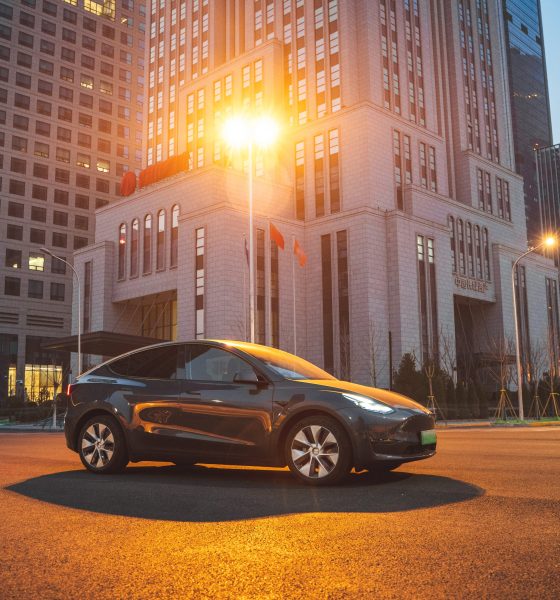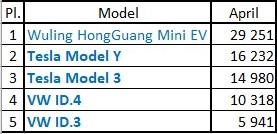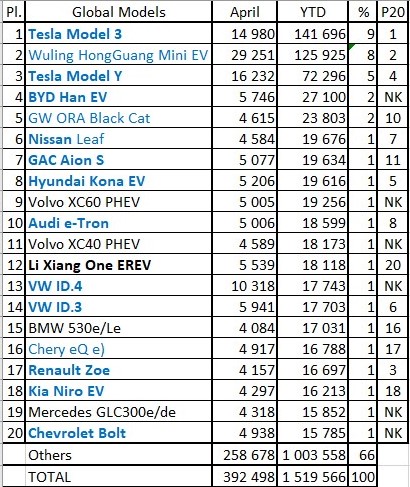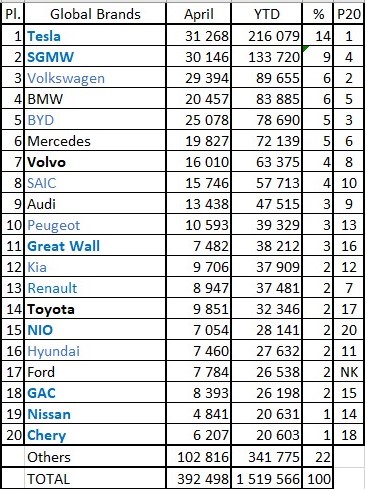

News
Tesla Model Y overtakes Model 3 in April Global EV sales, Model 3 #1 in 2021
The Tesla Model Y crossover has overtaken its sibling vehicle in the Tesla Model 3 in April’s global electric vehicle sales figures, new data shows.
In April, around 392,000 electric vehicles were registered globally, making it the fourth-best month in the history of electrification. Tesla, the world’s leader in electric vehicles, maintained 2nd and 3rd place on April’s sales charts, with the Model Y overtaking its sibling Model 3 for the first time globally.
The Model Y crossover debuted in March 2020 when Tesla first delivered the all-electric vehicle to customers. Since then, it has gained popularity thanks to its trendy body style and impressive performance specifications. Combine this with affordability, and the Model Y is one of the most appealing automobiles on the market today.
Credit: Tesla China/Twitter
In April, the Model Y accumulated 16,232 registrations, according to the EV Sales Blog, a website that tracks global electric vehicle sales. The Model 3 sold only 14,980, making it the third most popular EV globally. The first was the HongGuang Mini EV from Wuling. Its highly affordable price tag that starts at around $5,000 makes it one of the most popular vehicles globally despite not having standard features without additional charges. The vehicle is sold in China mostly, where the Wuling-General Motors-SAIC joint venture vehicle has dominated the Chinese EV sector’s sales figures for around 8 consecutive months.
Credit: EV Sales Blog
The Model Y overtaking the Model 3 was an impressive move, but it was something Tesla’s executives always imagined. “We’re confident this product will be our best-selling product ever,” Musk said in regards to the Model Y during the Q1 2020 Earnings Call. Tesla was able to achieve profitability with the Model Y in its first quarter of production, something that the automaker could never achieve with any of its previous vehicles.
Looking forward, Musk believes that the Model Y will be the best-selling car on Earth in 2022. “When it comes to Model Y, we think Model Y will be the best-selling car or vehicle of any kind in the world and probably next year,” Musk said during the Q1 2021 Earnings Call. “So I’m not 100% certain next year, but I think it’s quite likely. I’d say more likely than not, that in 2022, Model Y is the best-selling car or truck of any kind in the world.”
As for the year so far, the Model 3 still stands as the best-selling EV globally. Despite reports of a weak April, the Model 3 still maintains a healthy lead in the global EV market over the Wuling HongGuang Mini EV with 141,696 units sold. The latter vehicle stands at 125,925, while the Model Y’s strong April helped it maintain its third-place position on the chart with 72,296 cars sold this year.

Credit: EV Sales Blog
Tesla is still the most popular manufacturer of electric vehicles, according to more statistics. The Model 3 and Model Y have been two of Tesla’s most prominent vehicles so far, despite its very limited lineup of products. Tesla has not delivered a Model S or Model X this year that wasn’t already in its inventory due to a refresh that the automaker decided to perform on its flagship vehicles. This effectively means that Tesla is still dominating the global EV market with 14% of the total market share and 216,079 sales while only delivering half its vehicles. The SGMW joint venture sits in second place with 133,720, accounting for 9% of the market share.
Credit: EV Sales Blog
What do you think? Let us know in the comments below, or be sure to email me at joey@teslarati.com or on Twitter @KlenderJoey.

Elon Musk
Elon Musk and Tesla AI Director share insights after empty driver seat Robotaxi rides
The executives’ unoccupied tests hint at the rapid progress of Tesla’s unsupervised Robotaxi efforts.

Tesla CEO Elon Musk and AI Director Ashok Elluswamy celebrated Christmas Eve by sharing personal experiences with Robotaxi vehicles that had no safety monitor or occupant in the driver’s seat. Musk described the system’s “perfect driving” around Austin, while Elluswamy posted video from the back seat, calling it “an amazing experience.”
The executives’ unoccupied tests hint at the rapid progress of Tesla’s unsupervised Robotaxi efforts.
Elon and Ashok’s firsthand Robotaxi insights
Prior to Musk and the Tesla AI Director’s posts, sightings of unmanned Teslas navigating public roads were widely shared on social media. One such vehicle was spotted in Austin, Texas, which Elon Musk acknowleged by stating that “Testing is underway with no occupants in the car.”
Based on his Christmas Eve post, Musk seemed to have tested an unmanned Tesla himself. “A Tesla with no safety monitor in the car and me sitting in the passenger seat took me all around Austin on Sunday with perfect driving,” Musk wrote in his post.
Elluswamy responded with a 2-minute video showing himself in the rear of an unmanned Tesla. The video featured the vehicle’s empty front seats, as well as its smooth handling through real-world traffic. He captioned his video with the words, “It’s an amazing experience!”
Towards Unsupervised operations
During an xAI Hackathon earlier this month, Elon Musk mentioned that Tesla owed be removing Safety Monitors from its Robotaxis in Austin in just three weeks. “Unsupervised is pretty much solved at this point. So there will be Tesla Robotaxis operating in Austin with no one in them. Not even anyone in the passenger seat in about three weeks,” he said. Musk echoed similar estimates at the 2025 Annual Shareholder Meeting and the Q3 2025 earnings call.
Considering the insights that were posted Musk and Elluswamy, it does appear that Tesla is working hard towards operating its Robotaxis with no safety monitors. This is quite impressive considering that the service was launched just earlier this year.
Elon Musk
Starlink passes 9 million active customers just weeks after hitting 8 million
The milestone highlights the accelerating growth of Starlink, which has now been adding over 20,000 new users per day.

SpaceX’s Starlink satellite internet service has continued its rapid global expansion, surpassing 9 million active customers just weeks after crossing the 8 million mark.
The milestone highlights the accelerating growth of Starlink, which has now been adding over 20,000 new users per day.
9 million customers
In a post on X, SpaceX stated that Starlink now serves over 9 million active users across 155 countries, territories, and markets. The company reached 8 million customers in early November, meaning it added roughly 1 million subscribers in under seven weeks, or about 21,275 new users on average per day.
“Starlink is connecting more than 9M active customers with high-speed internet across 155 countries, territories, and many other markets,” Starlink wrote in a post on its official X account. SpaceX President Gwynne Shotwell also celebrated the milestone on X. “A huge thank you to all of our customers and congrats to the Starlink team for such an incredible product,” she wrote.
That growth rate reflects both rising demand for broadband in underserved regions and Starlink’s expanding satellite constellation, which now includes more than 9,000 low-Earth-orbit satellites designed to deliver high-speed, low-latency internet worldwide.
Starlink’s momentum
Starlink’s momentum has been building up. SpaceX reported 4.6 million Starlink customers in December 2024, followed by 7 million by August 2025, and 8 million customers in November. Independent data also suggests Starlink usage is rising sharply, with Cloudflare reporting that global web traffic from Starlink users more than doubled in 2025, as noted in an Insider report.
Starlink’s momentum is increasingly tied to SpaceX’s broader financial outlook. Elon Musk has said the satellite network is “by far” the company’s largest revenue driver, and reports suggest SpaceX may be positioning itself for an initial public offering as soon as next year, with valuations estimated as high as $1.5 trillion. Musk has also suggested in the past that Starlink could have its own IPO in the future.
News
NVIDIA Director of Robotics: Tesla FSD v14 is the first AI to pass the “Physical Turing Test”
After testing FSD v14, Fan stated that his experience with FSD felt magical at first, but it soon started to feel like a routine.

NVIDIA Director of Robotics Jim Fan has praised Tesla’s Full Self-Driving (Supervised) v14 as the first AI to pass what he described as a “Physical Turing Test.”
After testing FSD v14, Fan stated that his experience with FSD felt magical at first, but it soon started to feel like a routine. And just like smartphones today, removing it now would “actively hurt.”
Jim Fan’s hands-on FSD v14 impressions
Fan, a leading researcher in embodied AI who is currently solving Physical AI at NVIDIA and spearheading the company’s Project GR00T initiative, noted that he actually was late to the Tesla game. He was, however, one of the first to try out FSD v14.
“I was very late to own a Tesla but among the earliest to try out FSD v14. It’s perhaps the first time I experience an AI that passes the Physical Turing Test: after a long day at work, you press a button, lay back, and couldn’t tell if a neural net or a human drove you home,” Fan wrote in a post on X.
Fan added: “Despite knowing exactly how robot learning works, I still find it magical watching the steering wheel turn by itself. First it feels surreal, next it becomes routine. Then, like the smartphone, taking it away actively hurts. This is how humanity gets rewired and glued to god-like technologies.”
The Physical Turing Test
The original Turing Test was conceived by Alan Turing in 1950, and it was aimed at determining if a machine could exhibit behavior that is equivalent to or indistinguishable from a human. By focusing on text-based conversations, the original Turing Test set a high bar for natural language processing and machine learning.
This test has been passed by today’s large language models. However, the capability to converse in a humanlike manner is a completely different challenge from performing real-world problem-solving or physical interactions. Thus, Fan introduced the Physical Turing Test, which challenges AI systems to demonstrate intelligence through physical actions.
Based on Fan’s comments, Tesla has demonstrated these intelligent physical actions with FSD v14. Elon Musk agreed with the NVIDIA executive, stating in a post on X that with FSD v14, “you can sense the sentience maturing.” Musk also praised Tesla AI, calling it the best “real-world AI” today.








